




DEVELOPMENT
ONLINE
PROJECTS
 |
 |
 |
 |
 |
DEVELOPMENT |
ONLINE
PROJECTS |
|||||
| Hand Tools for Encaustic Work | |
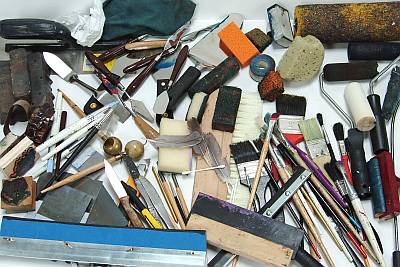 A SELECTION OF COMMONLY AVAILABLE HAND TOOLS |
There
are lots of commonly available hand tools to choose from and many more
to adapt. In fact anything that will help move or manipulate the wax colours into the forms, patterns, lines or spreading that you want can be happily embraced. This small selection is by no means comprehensive. A piece of serrated torn card can be as effective as the most expensive tools, provided its results are what you want to produce! |
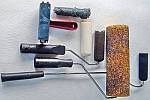 |
Rollers are usually associated with home decoration and used for rolling liquid paint onto walls and ceilings. But combined with hot air or hotplate tools that provide the magical heat solvent for wax, then these rollers come into a new life purpose. Different sizes, differing sponge textures, even long pile hair or solid brayers, all offer good effects. The regular sponge rollers are ideal for creating smooth backgrounds and colour gradations. See more about that in the hotplate section with John Buckland and another perspective from Elisabeth van Uden. |
 |
Sponges come in all sorts of material textures and sizes from hard fine types to softer open pore varieties. The synthetic ones are made in many shapes, so rounds or hard straight edges are easy to find. They are great for dabbing foliage and textural effects used either with hot air gun or hotplate. The iron mini-hotplate is an excellent palette for sourcing colours with a sponge - small & easy to clean. sponges |
 |
Rubber stamps and printing blocks can provide numerous shapes and edge details as well as their surface pattern. Unthought-of textures and patterns in encaustic work can be expressed through these interesting tools. Batik and fabric print blocks come in copper or wood. Rubber stamps are made by vulcanisation so the rubber is not affected by the molten wax heat. extract from Exploring Ideas |
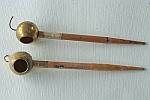 |
Tjanting tools are like small ladle pots with a thin fine pipe running to drain the wax that is captured in the tjanting when it is dipped into the wax pot. These are usually used for designing batik works, but if the pipe is broad enough to remain open as the wax colours pass through, then these can be used to trail wax lines onto your artwork. |
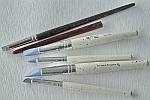 |
Wax movers, rubber and silicone tipped handles come in a variety of designs, shapes and sizes. The ends are used to move the wax colours around, or to blend them or pattern them. They can also be used to deposit small amounts of molten wax into areas of the encaustic artwork being addressed. scrapy wax movers |
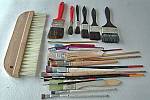 |
Brushes for art and other things are available in every imaginable shape and size. The important thing for molten wax use is to ensure that you choose materials in the fibrous brush end that will not melt. Natural hair is best, and a cheaper hogs hair is often preferable to the more refined types favored in watercolour. |
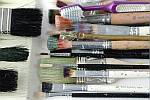 |
Brush sets can be kept for individual wax colours or by working "up and down the palette" a single brush can be used to create the whole painting. Cleaning can just be by wiping whilst still warm, so long as a similar colour or hue is being used next. More thorough cleaning is done by melting clear wax to "wash" and wipe out existing colour from the brushes. some encaustic hair brushes |
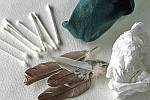 |
Soft fabrics, feathers, cotton buds, anything that can be used to smudge, wipe, move, remove, polish and so forth. Fabrics are great to aid with hot air and hotplate working, being ideal for blending and fine strokes. Good on absorbent papers too. The cotton buds are almost purpose made to carry small amounts of wax colour and behave very much like a felt tip pen or a torchon for smudging colours together. |
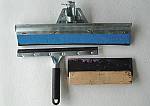 |
Squeegee tools are normally rubber, plastic or foam. All have their potentials as tools for moving molten encaustic wax and medium about. They do not have to be dragged but can be tapped on for long straight lines, or radiated around for sunray type markings. Obviously the foam ones will absorb the wax colours, so need more careful use. |
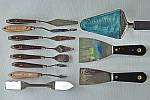 |
Palette knives, scrapers and spatulas are another family of tools, usually flexible metal ones, that provide a mass of potentials. These products abound the art shop market place, but for encaustic work they can be just as useful as if applied to oil paints. Lying their heads on the hotplate will make them instantly available for use on demand. |
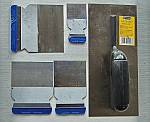 |
Trowels and filler blades offer another form of metal surface that responds well to heat applications. These rectangular ones are also called "japanese knives" and can be used with hot air or hotplate. The mini iron hotplate can be a good loading palette for them. Again, these can be used on edge to create thin sharp long lines and like the palette knife sets above, these also can be rested on the hotplate to stay warm and ready for action. Remember that the metal will get hot! |
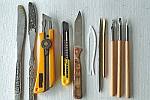 |
Knives, pens and scraping tools are another family of items which can be useful for the encaustic artist. Scratching and scraping detail through the wax, through layers of colour, to carve in accents and dimensional qualities, there really are so many possibilities for encaustic art work that the mind is automatically stimulated! |
Where next? - HOT TOOLS or maybe SUPPORT MATERIALS or the INDEX |
|
|